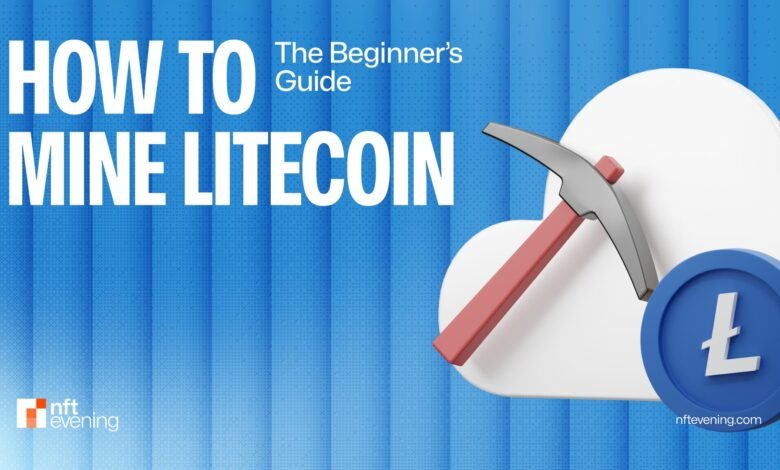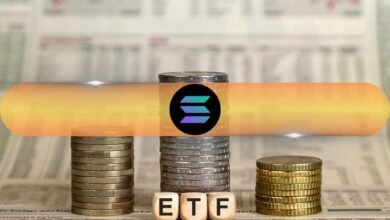How to Mine Litecoin: The Beginner’s Guide

For diehard cryptocurrency miners, Litecoin mining is a ‘silver medal’ exercise compared to Bitcoin’s ‘gold’ due to its speed and accessibility. If you’re here to learn how to mine Litecoin, this guide will equip you with everything you need to understand the mining process, required tools, and how to maximize mining profitability.
Whether you’re new or experienced in mining, we’ll start from the basics and walk you through each mining method. You’ll also learn what kind of hardware and operating system setup is required for a successful mining operation.
What Is Litecoin?
Litecoin is an open-source, peer-to-peer cryptocurrency developed in 2011 by Charlie Lee, a former Google engineer. Built using the same foundational technology as Bitcoin, it employs the Scrypt algorithm, which supports more memory-intensive computations and encourages decentralization.
Unlike fiat currencies, Litecoin is not governed by any central authority. Transactions are recorded transparently on a public blockchain. Thanks to lower fees and faster confirmations, Litecoin has positioned itself as a strong alternative for daily transactions and a popular choice in both Litecoin and Bitcoin mining circles.
In the world of cryptocurrencies, Litecoin was designed to be a lighter version of Bitcoin, intended to function like “silver where Bitcoin is gold.” The Scrypt hashing algorithm facilitates a larger supply limit and faster blocks generation times. LTC has also consistently ranked among the top 20 cryptocurrencies in market capitalization. Due to Litecoin’s lower transaction fees and faster confirmation times, it has become preferred for everyday transactions and is attractive to cryptocurrency miners.
Can You Mine Litecoin?
Yes, Litecoin can be mined using GPUs, CPUs, or ASICs. While early miners could use standard computers, increased difficulty now requires specialized hardware to ensure competitive mining performance. The mining process is more accessible than Bitcoin’s, attracting a broader user base.
Mining Litecoin offers income potential and contributes to the network’s decentralization and security. How much you earn depends on mining efficiency, energy costs, hardware investment, and market dynamics.
Why Mine Litecoin (LTC)?
There are several opportunities and advantages associated with mining Litecoin, including the following:
- Mining Rewards: If done right, mining Litecoin can generate steady income. Block rewards are paid in LTC, and their value may grow alongside Litecoin’s market performance.
- Support the Network: By processing and confirming transactions, miners help maintain the integrity and security of the Litecoin blockchain. Your participation reinforces decentralization and prevents single points of failure.
- Hands-on Learning: Engaging in Litecoin mining is a great way to explore blockchain mechanics, crypto technology, and decentralized infrastructure. It’s a practical path to building real-world knowledge in the digital asset space.
Litecoin mining consumes significant electricity, so maximizing mining efficiency is crucial to ensure sustainability and profitability.
The Role of Mining in Litecoin’s Ecosystem
Litecoin mining plays a significant role within the LTC ecosystem. It helps secure the network from attacks and maintains the health and functionality of the blockchain. Some of the essential functions that mining performs include:
- Network Security: LTC mining authenticates transactions before adding them to the blockchain, which ensures the Litecoin network’s integrity and security. As a decentralized network, this makes the LTC blockchain resistant to 51% attacks since no single individual or entity can control the majority of mining power.
- Creation of New Coins: Miners are rewarded with the newly issued LTC coins. The process progressively adds LTC coins to the circulating supply until the maximum of 84 million coins is reached.
- Decentralization: Scrypt, Litecoin’s mining algorithm, is more accessible than Bitcoin’s SAH-256, meaning more people and organizations can participate in the mining exercise. This kind of decentralization ensures no group of people can control the network to their advantage at the expense of others.
- Transaction Validation: Miners are responsible for solving complex mathematical puzzles that help validate transactions, after which they add them to the blockchain and ensure they are recorded correctly.
- Halving: The halving event, which happens after approximately four years and halves the mining rewards, helps to control the circulating supply of LTC, ensuring a gradual and systematic decrease in the rate at which new coins are issued. This helps to maintain scarcity and potentially increase the value of the cryptocurrency.
How Does Litecoin Mining Work?
Litecoin resembles Bitcoin in using the proof-of-work consensus mechanism, which enables users who can dedicate computing power to validate transactions, add new blocks to the network, and earn the newly created LTC coins. When someone sends Litecoin through the network, the transaction appears on the blockchain. However, the transaction needs to be validated before it can be included in the transaction block.
This confirmation is accomplished by a computer within the network, known as a miner. Miners are powerful computers that perform calculations to authenticate a transaction before it can be added to a transaction block. The Litecoin miner or group of miners that cracks the puzzle first is rewarded with block rewards. The block reward refers to the newly minted coins created when a block full of transactions is added to the chain.
As more miners connect and start working on the network, the Litecoin blockchain becomes more accessible to more users. This helps to maintain decentralization and eliminate single points of failure. The increased computational power used for mining on the PTC network, therefore, enhances security. As a result, no single entity can overpower it and take control.
In the beginning, anyone could use a standard CPU or GPU to mine Litecoin at home, but things have changed. As the network grew, the system required more computational power to compete to solve the cryptographic puzzle. This led to increasing the “difficulty” of mining. This has led to the creation of ASIC LTC mining hardware specifically designed for the Scrypt algorithm.
What Equipment Do You Need to Start Mining Litecoin?

Previously it was possible to mine Litecoin using standard consumer-grade CPUs or GPUs. You now need to make an investment in some form of equipment for the chance to become profitable. The following is a list of equipment you need so you can potentially earn from mining:
1. Litecoin mining hardware
Initially, you only needed a good graphics processing unit (GPU) or central processing unit (CPU) to make a good profit. Miners only required a small investment to make a good return. However, you now need specialized LTC mining hardware, specifically Application-Specific Integrated Circuit (ASIC) chips.
ASICs are stronger than GPUs and CPUs. This gives users a better chance of cracking the PoW cryptographic puzzle to earn the mining reward. While you could still stand a chance mining with GPUs, the chances are too slim for anyone to try. However, you need to compare the power consumption, hashrates, and prices before buying ASIC miners.
2. Litecoin mining software
Once you have picked the proper hardware, it is now time to install the appropriate LTC mining software. This refers to a computer program that enables your mining rig to interact with the Litecoin blockchain. It also links you to a mining pool if you prefer taking that direction. Choosing the right Litecoin mining software is the difference between making a profit or lack of it. The software is also essential in helping you track your performance. The best thing to remember about LTC mining software is that it’s primarily easy to set up. The installation file helps you decide between mining Litecoin alone and joining a mining pool.
3. Litecoin wallets
After selecting the right equipment and software, you need a location to store all the LTC coins you’ll earn. You need a secure Litecoin wallet to avoid leaving your crypto in an exchange wallet. Your assets are safer in an LTC wallet and not susceptible to hacking or other forms of cybercrime. You have a choice between a software and hardware wallet. Whatever you choose, always back up your seed phrase or private keys to safeguard your LTC coins. Back up private keys or seed phrases in a secure location and store your idle coins in a hardware wallet.
How to Choose LTC Mining Hardware
Below are the most important factors to consider when choosing the best Litecoin mining hardware:
- Hashrate: The hashrate refers to the speed at which mining hardware can solve math puzzles. The greater a computer’s hashrate, the higher the chance you’re likely to earn a reward and move toward profitability. As such, ensure that you go for mining hardware with a high hashrate.
- Power Consumption: The energy consumption rate of mining hardware has the most significant impact on a miner’s profitability. The computational tasks of mining hardware consume a lot of electricity, meaning that power consumption can easily eat into your profit margin. Consider the energy consumption rate of your miner when selecting hardware.
- Cost: The cost of LTC mining hardware will vary depending on whether you’re buying CPU, GPU, or ASIC, with CPUs being the most affordable and ASICs the most expensive. When comparing prices, remember that cheaper isn’t always better because the hashrate the equipment offers isare what makes the difference between the profitability of your investment and its lack.
- Reliability: Always ensure that you choose mining hardware from a trusted and reputable manufacturer, as poor-quality hardware can increase downtime, resulting in lost income and profit.
- Compatibility with Mining Software: For your chosen hardware to work effectively, it must be compatible with the mining software you intend to use, as some support only specific hardware. Consider the type of mining software that supports most of the available software types.
Types of Mining Hardware
- CPU Mining: The use of CPUs (Central Processing Unit) is the most accessible and affordable of all mining hardware. However, note that these are not specialized mining equipment. They have a low hashrate compared to the rest, meaning it’s less efficient and not as profitable.
- GPU Mining: The second option for LTC mining is GPU (Graphics Processing Unit), which offers a slightly higher hashrate than the standard CPU and can handle various mining algorithms. Nonetheless, apart from consuming relatively higher amounts of electricity, GPUs also become obsolete more quickly. Manufacturers are constantly releasing more powerful models.
- ASIC Mining: ASIC (Application-Specific Integrated Circuit) miners are specialized cryptocurrency mining hardware designed for mining tasks, which will likely lead to increased profitability. The most significant downside is that you must dig deeper into your pocket to get an ASIC miner.
Methods of Litecoin Mining
Litecoin mining doesn’t have to be intimidating. You only need correct knowledge and the right tools to start earning block rewards contributing to the security of Litecoin. The mining method you choose determines the investment you will put in and the potential outcomes of your venture. The following are the most common methods of LTC mining you can consider:
1. Solo mining
A solo miner connects to the Litecoin network as an independent node, and mines LTC blocks using their own hardware. Solving the cryptographic puzzle to validate transactions and add new blocks to the chain earns 12.5 LTC coins. If you want to enjoy this amount alone, you can start working as a solo miner. The advantage of Solo mining is that once you earn block rewards, they are all yours for the keeping.
However, this comes with a rider. The chances of a single node solving the mathematical puzzle remain very low. You will be competing against other solo miners and large mining pools that spend enormous computing power. While it’s still possible to use your ordinary CPU or GPU for LTC mining, there’s no guarantee of profitability. Suppose you’re going to engage as a solo miner. In that case, you need to use specialized mining hardware. Better still, consider cloud mining or pool mining to increase your chances of profitability.
2. Pool mining
Considering how difficult it is to succeed as a solo miner, the next possibility is joining Litecoin mining pools. Here users combine computational power to increase their odds of solving the mathematical puzzle. Once they win the 12.5 LTC coins reward, they divide their earnings among the participants.
The amount of profit each member receives is based upon the amount of hashing power they contribute. This means every member of the pool needs to have powerful mining hardware when they join the pool. If you don’t have the financial muscle to implement high-end mining equipment, join a mining pool. This is your best odd at a guaranteed supply of income. Note also that most mining pools will keep between 0.1% and 4% of the profit as a service charge.
3. Cloud mining
Besides solo mining and pool mining, there’s a less common form of LTC mining called cloud mining. Users who subscribe to this method pay a subscription fee to a cloud mining service provider. They rent a percentage of their computational power to them. For the price a user pays, the service provider does the crypto mining on their behalf. Then they share the profits based on the amount of subscription they paid.
You don’t have to buy mining equipment to participate in cloud mining. Instead, the mining company owns and operates the equipment located in its facility. You only need to register and sign a mining contract. Be careful when registering for cloud LTC mining, research the mining farm to ensure it isn’t a scam.
Best Litecoin Mining Pools
If you’re looking to mine Litecoin, here are some of the top mining pools worth considering:
- LitecoinPool.org: One of the oldest and most trusted LTC pools, launched in 2011 by a Litecoin developer. It uses the Pay-Per-Share (PPS) model and supports TLS encryption for added security. The platform runs servers in multiple regions and was once responsible for 40% of Litecoin’s total hash power. New users must apply for access.
- viaBTC: A major multi-coin mining pool, active since 2016. Supports both PPS and PPLNS payment models with no transaction fees and modest maintenance charges (4% for PPS, 2% for PPLNS). viaBTC also offers cloud mining, making it a good option for non-technical users.
- ProHashing: A versatile pool supporting Litecoin and other algorithms (SHA-256, Equihash, x11). It uses PPS payouts and lets you choose reward coins (LTC, BTC, or ETH). With auto-profit switching and coin merging features, it targets maximum earnings. Flat 4.99% fee applies.
- P2Pools: A decentralized, registration-free pool where miners connect via wallet address. It pays contributors directly using a sharechain, without third-party handling. Good for those who prefer smaller, decentralized alternatives. Notable nodes include Litecoin.tw and elitter.net.
How to Mine Litecoin (LTC): Step-by-Step Guide

Now that you know the benefits of LTC mining, it is time to learn “How to mine Litecoin on PC.” You could potentially be on your way to growing your LTC holdings.
Step 1: Get Litecoin Mining Hardware
The first step is to choose and assemble your mining gear-you must decide between using CPU, GPU, or ASIC. Once you have acquired it, carefully connect your PC to the power supply, cooling system or any other necessary components. If you’re installing ASIC, it should come with the manufacturer’s installation guide, which is easy to follow. Ensure that you evaluate your financial situation and make accurate comparisons, balancing cost and the productivity of mining devices. Investing in equipment from reputable hardware manufacturers can be a costly endeavor. However, it leads to more efficient mining, and the return on investment (ROI) may not be immediate.
Step 2: Choose Trusted Mining Software
Once your hardware is in place, it is time to install appropriate LTC mining software that’s compatible with your hardware. After the software is installed, configure it according to the details, ensuring it is compatible with the Scrypt algorithm.
Step 3: Join a Mining Pool or Start Solo Mining
If you have computational power to compete with the “Big Boys,” join the Litecoin network as a solo miner. Otherwise, join a mining pool to contribute hashing power and share the costs and profits based on contributions.
Step 4: Set up a Litecoin Wallet
Whether you’re just beginning Litecoin mining or interested in investing, you need a well-established and secure wallet. That’s where you store and secure your coins away from cryptocurrency exchanges as the need arises.
Hot wallets (online): These wallets connect to the internet and include desktop wallets, mobile apps, and web wallets. Leading examples include Exodus, Trust Wallet, and Paybis Wallet.
Cold wallets (offline): Cold wallets, which don’t connect to the internet, can take the form of paper wallets or hardware wallets, such as the Ledger Nano X and Trezor, and are ideal for long-term storage. Most of these wallets come in the form of USB sticks that store your keys offline and are best for also managing large amounts of crypto.
Step 5: Start mining Litecoin and Monitor
Once you’ve set up the systems, the final step is to start mining Litecoin and monitor your performance. You want to monitor your hardware for any malfunctions, especially overheating carefully. You also need to remember to align hashrates with your hardware’s capabilities to keep it going healthy. As the mining exercise continues, you can use dedicated online tools to monitor your profitability. Constantly check LTC’s price so you can know how to direct your mining efforts.
The Costs and Profitability of Litecoin Mining
Selecting the right software or hardware or, solo or pool mining, every step is crucial in determining profitability. Having said, the following are among the factors potentially affecting profitability:
- Hardware Costs: The best LTC mining hardware can be expensive initially, and profitability will not be seen immediately. Carefully choose the appropriate Litecoin miner, keeping in mind energy consumption and hashrates.
- Electricity Costs: The cost of power will have a direct impact on your profitability – considered affordable or renewable power sources to minimize electricity costs.
- Litecoin Price: The price of Litecoin has a direct impact on profitability, meaning the rewards will vary based on the market’s volatility.
- Mining Difficulty: As more miners join the network to contribute hashing power, it leads to increasing mining difficulty levels since greater difficulty translates to extra computational power and more time to mine.
- Mining Pool Fees: Mining pools may be more lucrative, but there are fees associated with using them that could eat into your profitability.
- Cooling and Maintenance Costs: The mining exercise generates a significant amount of heat, and your hardware requires adequate cooling, cleaning, and repair to remain in good condition and optimize hardware performance.
Challenges and Risks of Litecoin Mining
While LTC mining can be potentially lucrative, anyone involved in it should be aware of the following risks and challenges they could encounter:
- Mining costs: The possibility of having a good return on investment is tied to some factors a miner may be able to influence directly. This includes the price of the cryptocurrency, electricity costs, and others.
- Technical challenges: Most solo miners who lack technical expertise may face challenges in dealing with their hardware, especially when it overheats or malfunctions.
- Calculating profits: Everyone who gets involved in LTC mining wants to make a profit, but there are risks involved, like a high initial investment without the guarantee of making a return eventually.
Common Litecoin Mining Scams and How to Avoid Them
Like all other cryptocurrency-based activities, Litecoin mining has had its fair share of scams. You need to be aware of the tactics used by scammers so you can take preventive measures. Among the most common scams are:
- Cloud Mining Scams: These are online platforms that offer non-existent cloud mining, promising lucrative returns to those who subscribe to them. You can avoid scams by carefully researching and being wary when the promised returns are too good to be true or when they ask for a hefty upfront investment.
- Fake Mining Pools: Fraudsters can create fake mining pools whose websites resemble the genuine ones but are well designed to steal your LTC coins. Only use trusted, reputable mining pools, verifies a website before committing to use it. Be wary of relatively new mining pools promising excessive block rewards.
- Fake Wallets: Cybercriminals have what it takes to create fake wallets that resemble the real ones but are designed to steal your private keys and get access to your investment. Ensure that you download wallets from verified, reputable wallet providers. Some red flags include unsolicited requests for private keys, suspicious emails, and poorly designed websites.
- Phishing Attacks: Scammers use fake emails or websites that resemble legitimate sources to try and steal your private keys or credentials. Always verify the authenticity of any emails or websites before clicking on links or entering your personal information. In addition to being wary of unsolicited requests, always use strong, unique passwords.
- Ponzi schemes involve fraudsters who promise users high returns for recruiting new members to mining pools rather than engaging in the actual mining activity.
- Romance scams: Scammers lure users by building online relationships and then ask for money to invest in opportunities.
The Future of Litecoin Mining
Just like the LTC coin itself, the future of Litecoin mining presents a combination of opportunities and challenges. Experts believe Litecoin holds the potential for exponential growth in the years ahead. While new stars have been born with each crypto cycle, Litecoin has demonstrated its resilience. The token has maintained its position among the top 20 cryptocurrencies according to market capitalization.
Among the factors that have allowed LTC to keep on shining include:
- Proven Track Record: LTC has been around for over 10 years and hasn’t recorded any significant security issues.
- Liquidity: Since the token is traded on virtually all major cryptocurrency exchanges with reasonable daily volume, Litecoin miners are kept on their toes, validating transactions.
- Adoption: With more merchants accepting Litecoin as a form of payment, the ongoing adoption for use in micropayments, tipping, and cross-border transfers means increased transactions and mining opportunities as demand rises.
The cryptocurrency market remains highly volatile. But regulatory changes, market sentiment, and technological advancements, may also influence the price of LTC. Miners can be assured that ongoing adoption and use of the right strategies has their work cut out for them. There’s still hope until the last of the 84 million LTC coins are mined. However, it’s always recommended that you approach crypto-based investments cautiously and after doing thorough research.
Conclusion
Litecoin mining can be potentially lucrative, but to be successful, you must invest in knowledge and the right technology. As much as possible, try and get a steady source of affordable energy. Nonetheless, remember that the Litecoin mining sector is highly competitive. Since it’s constantly evolving, invest in gaining current knowledge to remain updated and respond to changes promptly.
While LTC mining remains profitable, it is essential to remember that profitability may not always be guaranteed. Profitability can be affected by factors like, including energy costs, block rewards, and the price of LTC, among others. Closely monitor the mining landscape’s response to the changing regulatory landscape.
FAQs
Is mining Litecoin profitable?
Whether Litecoin mining is profitable or not depends on several factors. These include mining difficulty, the price of LTC, the efficiency of a user’s mining hardware, and energy costs. Miners should calculate their potential profits by factoring in all expenses before determining whether they have made a profit.
How to mine Litecoin on Android?
Mining Litecoin on an Android device is complicated because phones and other similar devices don’t have sufficient processing power. Also, there’s always the risk of damage to the device due to overheating. Nonetheless, the following is a step-by-step process for anyone wishing to mine Litecoin on their smartphone.
- Download mobile mining app: Install a mobile app that supports Litecoin mining on your device and register an account.
- Set up a wallet: You need a cryptocurrency wallet to secure your seed phrase to protect your coins.
- Join a mining pool: Look for a mining pool you can join, as it’s easier to mine when you combine hashing power with other miners.
- Configure settings: Enter your wallet address and any other required information in the mining app to start mining. Take care, though, not to overstrain your gadget, especially the battery and CPU.
- Start mining: Once you start LTC mining, it’s essential to constantly monitor your phone’s temperature and performance to prevent potential damage.
How to mine Litecoin on pc?
Mining Litecoin on a PC may not be as efficient as it can be when using an ASIC miner, but it is still possible. This is what to do if you are interested but lack sufficient funds to start. The following is a short guide you can follow:
- Choose Mining Hardware: If your PC has a relatively strong CPU, consider selecting suitable hardware, such as the Nvidia GTX 1070 or AMD Radeon RX 580.
- Download a Litecoin Wallet: Download and set up a Litecoin wallet by following the instructions to secure it.
- Install Mining Software: Install applicable software that supports your CPU or GPU operating system.
- Join a Mining Pool: While it’s possible to mine Litecoin solo, you can increase your chances of profitability by joining a mining pool. Once you register, configure your software and connect with the pool.
- Configure Your Software and Start Mining: The final step involves configuring your software for optimal performance. As you begin mining, remember to keep an eye on your PC, mainly to ensure it is running smoothly and prevent overheating.
What equipment is needed to mine Litecoin?
To mine Litecoin (LTC), you will need specialized hardware called ASIC miners (Application-Specific Integrated Circuits) or powerful GPUs (Graphics Processing Units). These devices are designed to perform the complex calculations required for mining more efficiently than traditional central processing units (CPUs).
How long does it take to mine 1 Litecoin?
The average time it takes to mine a single Litecoin is approximately 2.5 minutes, and for every mined LTC coin, the miner receives 12.5 Litecoin.
Source link



